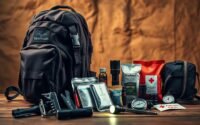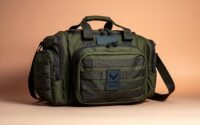Prepare for Emergencies with a Vehicle Emergency Kit
Nearly 6 million police-reported crashes occurred in 2023, and AAA answered over 30 million roadside calls. Those numbers show how often normal trips turn into urgent situations.
You can take a simple step today to boost your safety on the road. A compact car emergency kit gives you tools and basic supplies to handle dead batteries, flat tires, or minor injuries until help arrives.
Proper planning and regular updates matter. Keep first-aid items, visibility gear, jumper cables, tire repair tools, water, and nonperishable food in one place. That organization reduces stress and speeds decisions when seconds count.
Key Takeaways
- A well-stocked kit improves your safety and peace mind on trips.
- Simple tools cut response time for common car problems.
- Include medical, visibility, power, tire, warmth, and hydration items.
- Update supplies seasonally and before long drives.
- Using a checklist makes assembly and storage easy.
Your Roadside Reality Check: Why Planning Your Car Emergency Kit Matters Now
Millions of reported crashes and roadside calls show how often routine trips turn risky. The NHTSA logged nearly 6 million police-reported crashes in 2023, and AAA fields over 30 million roadside calls each year. Those numbers are why you should act now.
Severe weather — from snowstorms to heat waves — and incidents like highway closures can strand you for hours. When that happens, a compact car emergency stash helps you address dead batteries, flat tires, or visibility hazards.
Proper planning and regular updates are crucial. A prepared bag lets you stay warm, hydrated, and connected while you wait for help. It also reduces panic and speeds safe decisions on the road.
- Quantify the risk: national crash and tow data make planning practical.
- Reduce exposure: supplies cut time spent in dangerous spots.
- Fit your routes: tailor contents to typical weather and local conditions.
Bookmark this guide and check it often so your plan evolves with new tips and products. That simple habit gives you real peace mind when emergencies strike.
Vehicle Emergency Kits: Building Mobile Readiness — The Core Checklist You Should Pack
A compact checklist turns uncertainty into fast action when roadside problems arise. Use a focused packing list to cover medical, visibility, power, tire, nourishment, warmth, tools, and communication needs. Prioritize multi-use items so your space and weight are efficient.
Medical first aid kit essentials for on-the-road safety
Carry a first aid kit stocked with bandages, antiseptic wipes, gauze, gloves, and basic pain relievers. Include allergy meds and a compact CPR mask.
Visibility and signaling
Pack reflective triangles or LED flares and a bright flashlight with spare batteries so other drivers spot you on the road. High-visibility vests add extra protection when you step outside the car.
Power solutions
Bring jumper cables or a portable jump starter, a power bank, and a car phone charger. These items keep lights on and let you call for help if the battery dies.
Tire trouble tools
Keep a spare tire in good condition, a jack, lug wrench, repair plugs, and a compact inflator. Practice using these tools so a flat becomes a short delay, not a long one.
- Water: one gallon per person per day.
- Food: energy bars and nuts that store well.
- Warmth: blankets, warm layers, and hand warmers.
- Communication: hand-crank radio and paper maps.
Proper planning and consideration are two of the more important keys in survival prep. Take them seriously. Bookmark this guide and return often for updated tips on your car emergency kit and first aid supplies to keep you safe.
Beyond the Basics: Smart Add‑Ons That Elevate Your Well‑Stocked Car Emergency Kit
Smart extras help you handle fire, slick surfaces, and sudden storms without waiting for help.
Add an automotive-rated fire extinguisher to control small blazes early. This is a compact, car-safe extinguisher that complements your core first-aid and power items.
Traction and recovery tools
Pack a compact shovel plus sand or cat litter for traction. Include a tow rope or strap sized to your vehicle weight. These tools help you self-recover in snow, mud, or soft ground without spinning wheels.
Weather and repair basics
Keep a rain poncho and durable work gloves so you can handle cables, straps, or sharp debris safely. Add duct tape for temporary fixes and small-denomination cash for fuel or tolls in areas with limited card access.
- Organize: use small pouches so items are easy to reach.
- Tailor: choose add-ons for the conditions and areas you drive most.
- Benefit: these enhancements shorten delays and boost overall safety.
Proper planning and consideration are two of the more important keys in survival prep. Take them seriously. We continually update this blog. So, bookmark it and come back frequently for the latest survival information.
Seasonal and Regional Readiness: Winter, Summer, Urban, and Rural Considerations
Cold months, hot spells, city streets, and back roads each require targeted planning. Start by matching gear to the season and to the places you drive most. That small effort makes a big difference when conditions turn difficult.
Winter driving kit upgrades for snow, ice, and low temps
Pack an ice scraper and snow brush, extra warm clothing, hand warmers, and a folding shovel. These items help you clear windows, stay warm, and free a stuck car in icy conditions.
Summer heat readiness: extra water, sunshade, sunscreen
In hot weather carry extra water, a windshield sunshade, and sunscreen. A cool cabin lowers stress and helps you avoid heat-related problems during long roadside waits.
Urban vs. rural roads: navigation, coverage, and assistance gaps
In cities, keep a window breaker/seatbelt cutter and local transit info for quick detours or evacuations. For rural areas pack paper maps, a CB or satellite communicator, and extra food since response times can be longer.
“Proper planning and consideration are two of the more important keys in survival prep. Take them seriously.”
- Match your vehicle and tire choices to seasonal conditions.
- Review recent weather for the areas you drive and swap gear before the season changes.
- Add small comforts—thermal blankets for winter and electrolyte packets for summer—to manage stress in prolonged emergencies.
Want more guidance? See local preparedness tips at be prepared and update your car emergency list each season.
Family and Commuter Variations: Customize Your Kit for Different Drivers
Think about who uses the car most, then pack to match those needs. A tailored approach makes your supplies more useful when time matters.
Kits for families: kids’ needs and comfort
Pack child-focused items: children’s medications, allergy treatments, diapers, formula, and familiar comfort items like books or small games. These reduce stress during long roadside delays.
Keep a clear, labeled first aid kit in the front cabin as well as a larger aid kit in the trunk. That way, basic first aid is always within reach.
Solo commuters: compact, multi-use gear
For daily travel, choose compact, multi-use items and a small organizer that fits under a seat. A headlamp or hands-free light and a portable power bank help you manage tasks while keeping your hands free.
Store charge cables and a backup copy of emergency contacts and medical info in a waterproof sleeve. This helps responders and speeds coordination.
| Driver Type | Key Additions | Why it helps |
|---|---|---|
| Family | Children’s meds, diapers, comfort items | Reduces stress, supports health needs |
| Solo commuter | Headlamp, power bank, compact organizer | Space-efficient, keeps phone charged |
| Both | Front cabin first aid kit, waterproof contact list | Fast access, better coordination with responders |
“Proper planning and consideration are two of the more important keys in survival prep. Take them seriously.”
Maintenance and Updates: Keep Your Emergency Kit Road‑Ready at All Times
Simple, scheduled checks keep small faults from turning into big problems on the road.
Set a six‑month reminder to inspect your kit. Replace expired food and medical items, confirm batteries still power your flashlight and radio, and check tool condition.
Test gear you might rely on. Run your jump starter and inflator, switch on radios, and inflate a tire briefly so you catch issues before an emergency exposes them.

Seasonal swaps and quick actions
Make seasonal updates before weather shifts. Add ice scrapers and warm layers before winter. Bring sunscreen and insect repellent as temperatures rise.
- Rotate water, snacks, and medications ahead of expiry and log dates on a simple checklist you keep with the kit.
- Inspect cords, straps, and cases for damage so small issues don’t become failures during a roadside stop.
- Top up any items used after an incident immediately to keep your car ready.
“Proper planning and consideration are two of the more important keys in survival prep. Take them seriously. We continually update this blog. So, bookmark it and come back frequently for the latest survival information.”
Quick-Use Guidance: What to Do First in Common Emergencies
When a common roadside problem appears, fast, calm actions cut risk and time lost.
Dead battery, flat tires, and low‑visibility stops
Make the scene safe first. Move off the road if you can, switch on hazards, and place reflective triangles or LED flares to alert oncoming drivers.
For a dead battery, consult your kit. Use a portable jumper if you are alone or connect jumper cables when another car can help. Keep your phone charged with a power bank so you can call for help.
For flat tires, assess the damage. Use a plug and inflator for small holes. Swap to a spare using your jack and lug wrench when the case requires it. Check tire pressure before you drive away.
- Stay on the shoulder side of the car and avoid traffic-side exposure.
- Use a flashlight or headlamp and wear reflective gear in low light.
- Call for help when conditions, tools, or safety concerns exceed your comfort level.
Proper planning and consideration are two of the more important keys in survival prep. Take them seriously.
“We continually update this blog. So, bookmark it and come back frequently for the latest survival information.”
Conclusion
Simple routines—pack, check, practice—make a real difference during roadside incidents. Build a compact car emergency kit that blends a first aid kit, flashlight, jumper cables, water, food, and tire tools. Keep add-ons like a shovel or extinguisher for the areas you drive most.
Audit your kit every six months. Rotate batteries and supplies, test power gear, and swap seasonal items for winter or summer. Practice basics—boost a battery, plug a tire, set triangles—so you act with confidence.
Proper planning and consideration are two of the more important keys in survival prep. Take them seriously. Bookmark this guide and return often for updates that make your well-stocked car emergency setup more reliable and help you stay safe and gain peace mind.
FAQ
What should I include in a basic car emergency kit?
Start with a first aid kit, flashlight with extra batteries, jumper cables or a portable jump starter, tire repair kit and inflator, jack and lug wrench, reflective triangles or road flares, water, and nonperishable snacks. Add a phone charger, multi-tool, and warm blanket to cover common roadside problems.
How often should I check and update my kit?
Inspect your kit every six months. Replace expired medications, food, and batteries, top off water, and test electronic items like power banks and radios. Swap seasonal items—winter gear for cold months, extra water and sun protection for summer.
What medical supplies are essential for on-the-road safety?
Your aid kit should include adhesive bandages, sterile gauze pads, adhesive tape, antiseptic wipes, tweezers, scissors, disposable gloves, pain relievers, and any personal prescription medicines. Include an emergency blanket and a CPR mask if space allows.
Which power solutions are best if my battery dies?
Keep quality jumper cables or a compact portable jump starter. Carry a certified car phone charger and a high-capacity power bank to keep devices charged for calls and navigation. Choose a jump starter with built-in safety protections and LED indicators.
How do I handle a flat tire when I’m alone?
Find a level, safe spot away from traffic and set up reflective triangles. Use your jack and lug wrench to remove the flat and install the spare. If you have a repair kit and inflator, you can temporarily seal small punctures to reach a service station. Call roadside assistance if the situation feels unsafe.
What additions make a well-stocked car kit better for winter?
Add an ice scraper, folding shovel, traction aids like sand or cat litter, heavy blankets, hand warmers, extra warm clothing, and a tow rope. Include a small container of antifreeze and ensure your phone charger and power bank are fully charged before travel.
Are there smart add-ons that improve safety and comfort?
Yes. An automotive fire extinguisher, high-visibility vest, small tool set or multi-tool, duct tape, work gloves, rain poncho, and a few dollars in cash increase preparedness. A battery-powered or hand-crank emergency radio helps you stay informed during outages.
How should I customize the kit for family travel?
Pack child-specific items: snacks, diapers, wipes, medications, comfort toys, and extra clothing. Add a larger first aid kit and extra water. Consider a small activity kit to keep kids occupied during delays and a list of emergency contacts accessible to caregivers.
What differs for urban vs. rural driving kits?
In cities, prioritize compact gear, public transit alternatives, and cash for short help. In rural areas, carry extra water, more fuel-safe food, reliable navigation tools, a paper map, and stronger recovery tools like a tow strap and shovel due to longer response times.
How can I prepare for a dead battery without jumper cables?
If you don’t have jumper cables, use a portable jump starter or call roadside assistance. Keep your phone charged, stay with your car in a safe location, and use reflective signaling to alert passing drivers. Consider joining an auto club for emergency support.
What should I do for low-visibility roadside stops at night?
Pull as far off the road as possible, turn on hazard lights, set up reflective triangles or road flares behind your vehicle, and wear a high-visibility vest if you exit the car. Call for help and stay inside with doors locked if you feel unsafe.
How much water and food should I keep in the car?
Keep at least one gallon of water per person per day for a minimum of 24–48 hours, and pack shelf-stable, high-calorie snacks like energy bars, nuts, and dried fruit. Replace supplies regularly to ensure freshness and usability.


